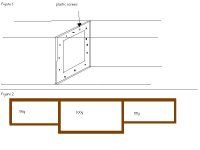Let me run another idea by you, or anyone else who feels qualified to chip in (or even if you don't feel qualified

).
How about instead of using acrylic cement to attach a couple tanks making whatever monstrosity I'm thinking up permanent (ie say I had 16 feet worth of tanks, that'll be pretty damn permanent since I most likely wouldn't be able to even angle it to get it out of the door, or worse having to do it on site), what if I use plastic screws to hold them together, sort of like a pressure pipe, then use some silicone or a flange inbetween them and just tighten it up. (see Figure 1 below)
Now from a practicality standpoint this would seem more ideal since
-individual tanks can have holes cut/drilled anywhere and connected later
-if for whatever reason need to move it I can disassemble into individual tanks
-No need to worry about getting a crappy weld because I had to apply the cement to a vertical surface rather than horizontal
-If it did develope a leak, chances are it wouldn't be a catastrophic leak that requires draining the tank, and might be fixable by just tightening the screws a bit more
-Sure screws might look a tad ugly to start, but like everything else in a tank they'd be covered with algae
-Any mistakes in planning (ie it won't fit) can be fixed by removing a single tank rather than having to cut them all apart and start over.
Anyways, if you or anyone else has any ideas on this I'd love to hear them. Specifically I'm looking for things along the line of "This will never work there is a problem with <insert problem here> that'll cause <damaging make me cry thing here>" or even some along the lines of "Wow I never thought of that, and have no idea how that'll work" (although I'd rather some who know what they're talking about say the last one, since just about anyone could say that I'm sure

). I'm just curious because I can try to find an 18g acrylic tank laying around and try it on a small scale first to put theory to test without going through a tremendous amount of trouble.
Also another question, assuming this isn't extremely far fetched already, would I be able to use tanks of different sizes? Since getting all the same exact size of tank might be an issue. I'm wondering how the pressure against the acrylic would pan out, if I had say 55g tanks that were only 16" deep, hooked to a 100g that's 20" deep would the acrylic bow any further? Initially I'd say no since the pressure that's exerted on the walls should be determined by how much water is above it. But again, I'm looking for someone to chime in with something I haven't thought of

Oh yah, I offically name this design/process after myself, incase I am the first loony guy to think it up, and would like full credit if someone with more resources (ie money) whips this up, ie I don't want to see the "Calfo Tank system" or whatever because they happen to write books

And in the case it has been thought up, I still want some credit because I figured it out independant of seeing the idea someplace

Alright enough jibber jabber







